Climate Change Mitigation – Rapid Change Needed To Restrict Global Warming To Below 2°C
Global greenhouse gas emissions and the carbon budget
The world’s climate is changing, but it remains possible to slow down the speed and extent of change if all countries, including New Zealand, play their part. Rapidly deploying the many different types of mitigation technologies and measures that are available, and developing effective policies to reduce greenhouse gas (GHG) emissions, can also produce many additional benefits that offset their overall cost. This was a key message from the Summary for Policy Makers of the 5th Assessment Report –Mitigation, of the Intergovernmental Panel on Climate Change (IPCC) [1] that was released in May 2014. It had been approved, sentence by sentence, by more than 140 government negotiating teams at a meeting in Berlin.
Since then the Paris Climate Agreement was signed by around 170 countries in May 2016, including New Zealand. Around 20 had ratified it by mid-2016. New Minister for Climate Change Issues, Paula Bennet, “hopes” New Zealand will ratify within 12 months but few policies yet exist to support meeting even our modest target of reducing total annual emissions to 11.2% below 1990 levels by 2030. It could be met by a mix of purchasing carbon credits off-shore (but who from and at what price is unknown), planting more forests to give net emission reductions, or taking mitigation actions domestically. Details of how New Zealand can do our fair share internationally across all sectors are outlined in a Royal Society of NZ report “Transition to a low-carbon economy for NZ” launched in May 2016 [2].
An earlier IPCC report on the Physical Science [3] confirmed that climate change is happening and is due to human activity. Past and future changes in global average temperature were shown to follow the total amount of carbon dioxide that has been emitted into the atmosphere since 1870. There is some delay in the temperature response and so past emissions alone will continue to create a warming that will reach about 1oC above the pre-industrial mean temperature (winter and summer, day and night, northern and southern hemisphere) of around 14oC. A second 2016 Royal Society of NZ report outlines the likely implications for New Zealand [4].
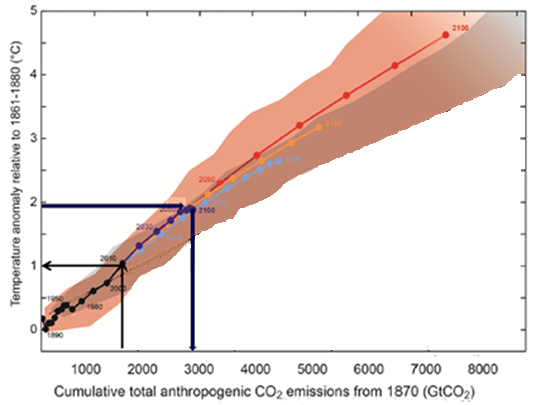
Figure 1: Total CO2 historic emissions to the atmosphere from 1870 until 2010 (black line) and four possible IPCC representative concentration pathways to 2100, with a greater temperature anomaly by the end of this century responding to higher CO2 emissions. To constrain a global temperature rise below 2oC, only around a further 1500 gigatonnes (Gt or billion tonnes) of CO2 can be released from fossil fuel combustion this century. This is far less than the known remaining fossil fuel reserves that could take us into an untenable 3-5oC future.
In spite of strong scientific evidence for the major impacts that can be caused by climate change [5], annual emissions continue to increase (Fig. 2) even though there are options for the deployment of new low-carbon technologies as well as regional, national, and local greenhouse gas emission reduction policies in many countries.
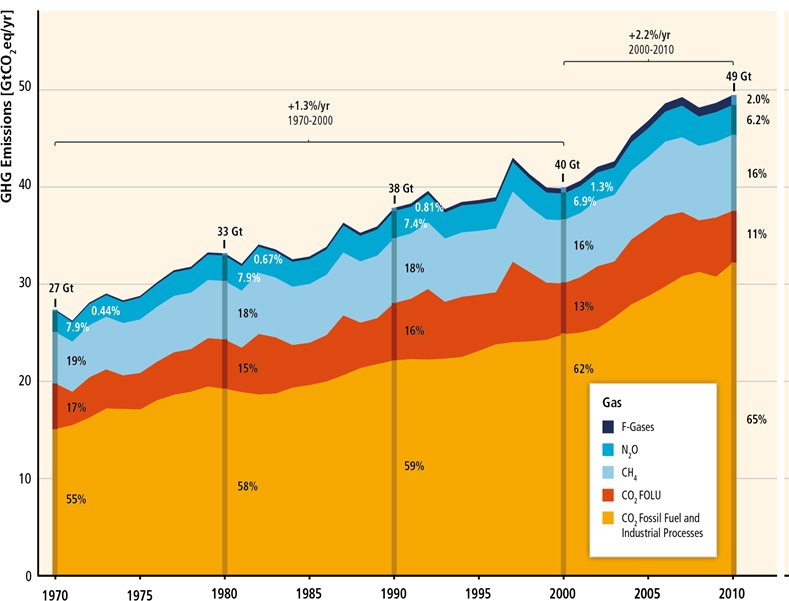
Figure 2. Global emissions of the family of greenhouse gases, including CO2 from agriculture, forests and other land use change (AFOLU), from 1970 till 2010 have continued to rise.
Despite some mitigation efforts, anthropogenic GHG emissions grew more rapidly from 2000 to 2010 than in each of the previous three decades (Figure 3). In the absence of additional mitigation efforts, integrated assessment models show that economic and population growth, together with other driving forces, would continue to raise GHG emissions and cause a median increase in global mean surface temperature of 3-5oC relative to pre-industrial levels by 2100.
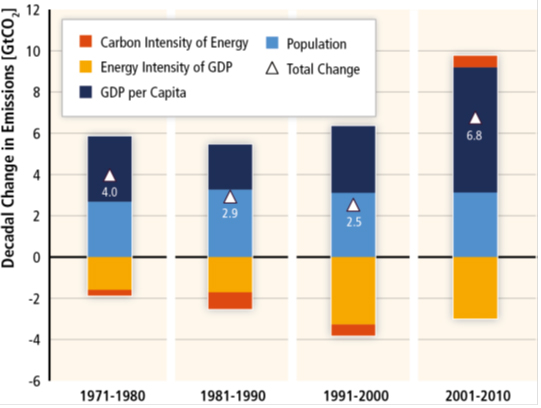
Figure 3. Decomposition of the change in total global CO2 emissions from fossil fuel combustion shows that a long standing trend of decarbonising the energy supply (reducing the carbon intensity of energy - red bars) was reversed in the last decade, mainly due to a renewed increase in the use of coal.
Only rapid, stark institutional and technological change can preserve a chance to limit global warming to the internationally agreed 2oC level above pre-industrial. Further delays in taking strong actions will increase the mitigation challenge, the costs, and the risks of exceeding this temperature threshold. Adapting to climate change impacts, such as sea level rise, is already inevitable, but can be much more manageable if very rapid mitigation of greenhouse gas emissions occurs in parallel. We need to both adapt and mitigate.
The challenge is that even if all countries meet their pledges made prior to the Paris Agreement (known as intended nationally determined contributions or INDCs), they are insufficient to match a pathway to limiting warming to below 2oC, never mind staying below the 1.5oC target also agreed in Paris (Fig. 4).
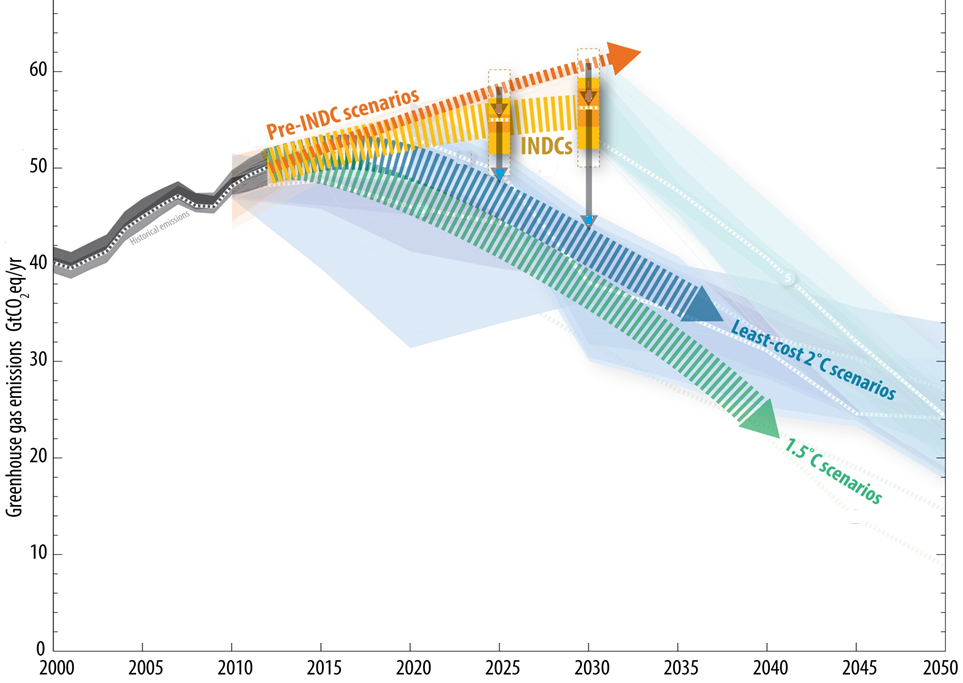
Figure 4. All the INDC pledges made for the Paris Climate Agreement are woefully short of reducing GHG emissions sufficiently to reach the pathways for constraining mean global temperature rise to below 1.5oC, or even 2oC.
Sectoral emissions
Direct emissions of carbon dioxide from the New Zealand energy supply sector, that generates heat and electricity mainly from the combustion of fossil fuels, can be allocated to the industry, buildings, transport, and agriculture sectors that use these energy services. Forests remove carbon dioxide from the atmosphere so give negative emissions but only those planted after 1989 receive credits in the UNFCCC process (Fig. 5). The various technological and social means of reducing sectoral emissions of CO2 and all the other GHGs are clearly outlined in the 2016 Royal Society “Low-Carbon Economy” report [2] (as well as in an earlier “green economy” report [6]). Many mitigation solutions also provide major additional co-benefits (such as lower local air pollution, improved health, reduced traffic congestion, more employment) that can actually save money for businesses and consumers.
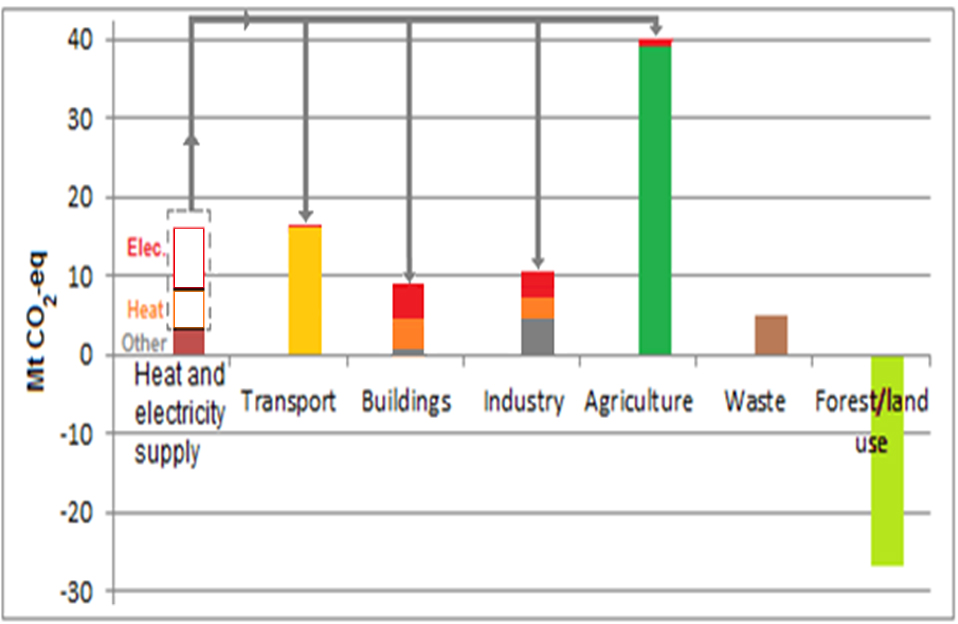
Figure 5. GHG emissions in 2013 for each sector in New Zealand with the arrows indicating the allocation of emissions from the centralized generation of heat and electricity when supplied to the industrial, buildings, transport and agriculture sectors (RSNZ, 2016).
Stabilizing GHG concentrations in the atmosphere at low levels requires mitigation throughout the economy. Successful efforts in one sector (such as electricity generation) will determine the need for mitigation efforts in the others. But low-stabilization scenarios are dependent upon a full decarbonization of energy supply in the long term, with electricity generation potentially becoming zero-carbon by around 2050 [2].
Reductions in energy demand through efficiency and behavioural change can also limit the mitigation risks, provide flexibility in the up-scaling of energy supply technologies, help avoid lock-in to carbon-intensive infrastructure, and increase the cost effectiveness of mitigation scenarios. For low- and middle-income countries, the challenge is for governments and communities to maintain their goals for sustainable development, improve lifestyles, and enhance food security, without becoming more reliant on fossil fuel inputs and deforestation. This will require considerable support from higher-income countries, including knowledge transfer, finance, capacity building, etc.
A wide range of options for decarbonizing energy supply is available including renewable energy systems, nuclear power and carbon dioxide capture and storage (CCS). These provide some flexibility in technology choice for a country depending on its circumstances and resources. Each set of energy supply technologies is associated with its own co-benefits, adverse side-effects and implementation challenges. Decarbonization of the electricity sector is projected to proceed faster than the switch to other low-GHG energy carriers in the end-use sectors.
In the transport, buildings and industry sectors, the wide-scale application of best-practice low-GHG technologies, complemented by behavioural changes and energy efficiency measures, can lead to substantial emission reductions [7]. The next two decades represent a window of opportunity for mitigation since a large portion of the world’s urban areas will be newly developed during this period, and spatial planning can help avoid lock-in to carbon intensive patterns of infrastructure and urban form. In established cities, mitigation is most effective when planning strategies and cross- sectoral policy instruments are aligned to increase accessibility, promote land-use mix, and reduce urban sprawl. The potential lies in retrofitting existing urban forms and modifying existing infrastructure.
The AFOLU sector plays a key role in low-stabilization scenarios because it provides options to remove carbon dioxide from the atmosphere through increasing soil carbon or linking biomass production with CCS. However, land-based mitigation can also increase competition between different land-uses for food, livelihoods, afforestation, reforestation, bioenergy, human settlements, and other economic sectors. Land management and multi-functional uses of land might help to reduce the associated risks and provide synergies between mitigation and other societal goals.
Policy-making for climate change raises issues of risk and uncertainty, of ethics, of social and economic goals and of sustainability. Analytical methods, along with insights from behavioural research, are available to inform policy-makers when attempting to manage these issues.
Financial and institutional barriers may be overcome by packages of complementary policies. Overall co-benefits for energy end-use measures, that take regional specificities into account, outweigh any adverse side-effects whereas the evidence suggests this is not the case for all supply side measures.
Many sectoral policies are available and some have already successfully reduced emissions at net negative social cost.
The number of national and sub-national mitigation policies to reduce GHG emissions, or to support low-GHG technologies, has continued to increase. In many countries these policies have helped to reduce emission intensity. Ambitious mitigation will require policies to be sufficiently effective to induce fundamental shifts in investment flows. There is an increasing focus on policy designed to integrate climate change mitigation with other economic, environmental and social objectives.
As a global commons problem, effective climate change mitigation requires strong international cooperation. The UN Framework Convention on Climate Change (UNFCCC) has provided a platform for coordinating efforts across nations. Other increasingly diverse forms of international cooperation developed over the past decade include linkages among regional, national and sub-national policies, and the inclusion of climate change issues in other policy arenas. The Kyoto Protocol was the first binding step toward implementing principles and mitigation goals but it has failed to significantly reduce global emissions because some countries did not ratify, and some did not meet their commitments. Furthermore, under Kyoto II out to 2020, the total commitments apply to only around 13% of total greenhouse gas emissions, not including developing countries, including China and others whose emissions have grown rapidly over the past decade.
The distributional impact of future international agreements will depend in part on the magnitude and sources of evolving financing as highlighted in Paris but yet to be negotiated. The Green Climate Fund has been pledged around $10 billion from donor countries, whereas it has been calculated by IEA that the INDCs will require a total investment of over $4 trillion out to 2030. Collaborative linkages and private sector investment can be established through regional co-operation such as embodying mitigation objectives in to trade agreements or the joint construction of infrastructure that facilitates reduction in carbon emissions. Linkages between carbon markets to improve market efficiency can also be stimulated by competition between and among public and private governance regimes.
New Zealand emissions
The argument that New Zealand produces only around 0.14% of the world’s greenhouse gas emissions is misleading. On average, each New Zealander is responsible for emitting around eight tonnes of carbon dioxide a year and, when agriculture and other greenhouse gases are included, our per capita emissions double. New Zealand now produces twice as much greenhouse gases per person than China and around eight times as much as India. This means we are one of the highest emitters per person in the OECD, behind Australia, the United States, and Canada, and we also have the second largest increase in greenhouse gas emissions since 1990 of all the countries that provide annual records to the UNFCCC [8].
The IPCC 2014 report on Risks, Adaptation and Vulnerability showed that countries, including New Zealand, will need to do a lot more to become resilient to the expected increase in extreme events and their impacts on communities, coasts, agricultural production and human health. Local governments have become responsible for addressing these threats, but there is a growing recognition of the need for much clearer coordination and support by the central government in order for this to become effective [9]. So far very little guidance has been given on how to adapt to change, how much it will cost, or who will pay the price. For example, a report on sea level rise by the Parliamentary Commissioner for the Environment was considered “speculative” by the present government [10].
The Government has, however, stated it is responsible for our mitigation policies. New Zealand has set somewhat modest targets to reduce our total greenhouse gas emissions (Fig. 6) but with few policies in place. At the time of writing, the emissions trading scheme (ETS) that has been largely ineffective to date, especially with the purchase of cheap carbon credits from offshore to meet commitments [11], is under review.

Figure 6. New Zealand’s net emissions mitigation targets for 2020, 2030 (our conditional INDC target) and 2050 are relatively modest, but even so, without strong policies, and with fewer CO2 removals projected from plantation forests, they will be challenging to meet.
In New Zealand’s Second Biennial report under the UNFCCC [12] in 2015, the Ministry of Environment projected our net greenhouse gas emissions (the total emitted minus the carbon dioxide absorbed by forests planted after 1990) will reach more than 75 Mt (million tonnes) in 2030 if we continue with business as usual (Fig. 7). To reach the target of 11.2% reduction below 1990 gross emissions by 2030 (Fig. 6) (around 59 Mt), without purchasing off-shore credits, will need urgent attention to reduce emissions across all sectors as detailed in the Royal Society “Low-Carbon Economy” report.
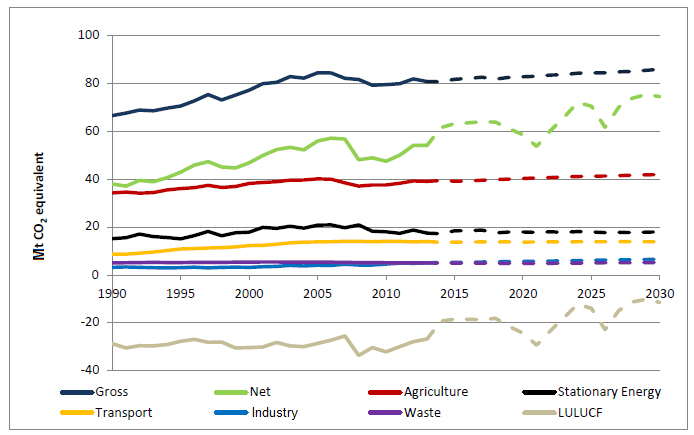
Figure 7. New Zealand’s historic greenhouse gas emissions from 1990 to 2010 (solid lines) and projected emissions to 2030 (dashed lines) by sector, with total gross emissions reduced to net emissions due to sequestration of carbon by plantation forests (land use, land use change and forests, LULUCF).
In the foreword of New Zealand’s 6th National Communication document to the United Nations, Minister Groser stated, ‘The emissions reduction opportunities available to other nations through conversion to renewables, mass public transport and energy efficiency in industry have already been done or have far less scope in New Zealand’. This is far from correct. Deep cuts in GHG emissions by New Zealand and all other countries will be needed to limit warming to 2°C relative to pre-industrial levels. New Zealand’s target remains achievable, but will entail challenging technological, economic, institutional, and behavioural changes by all businesses, organisations, communities, individuals and local, regional and national governments.
References
- http://report.mitigation2014.org/spm/ipcc_wg3_ar5_summary-for-policymakers_approved.pdf
- http://www.royalsociety.org.nz/expert-advice/papers/yr2016/mitigation-options-for-new-zealand
- http://www.ipcc.ch/report/ar5/wg1
- http://www.royalsociety.org.nz/expert-advice/papers/yr2016/climate-change-implications-for-new-zealand
- http://ipcc-wg2.gov/AR5/report
- https://zen.nzherald.co.nz/media/webcontent/document/pdf/201412/infographic.pdf and http://assets.royalsociety.org.nz/media/2014/05/Facing-the-future-towards-a-green-economy-for-NZ.pdf
- Details are provided in the sector chapters 7 to 11 in the IPCC 5th Assessment Report- Mitigation and in the Royal Society report “Transition to a Low-Carbon Economy for NZ”.
- http://unfccc.int/ghg_data/ghg_data_unfccc/items/4146.php
- http://www.lgnz.co.nz/home/news-and-media/2014-media-releases/local-government-proactive-on-risk-management
- http://home.nzcity.co.nz/news/article.aspx?id=216897&tst
- http://morganfoundation.org.nz/new-report-climate-cheats and http://www.listener.co.nz/archive/april-23-2016
- http://www.mfe.govt.nz/sites/default/files/media/Climate%20Change/second-biennial-report.pdf
This paper was peer reviewed by
Professor Martin Manning, School of Geography, Environment and Earth Sciences, Victoria University of Wellington.
While the reviewer has provided comment on drafts of this article, he does not necessarily endorse it in its final form. The author is solely responsible for any errors and judgements that may exist in the published article.
v.4.1 2nd August, 2016
